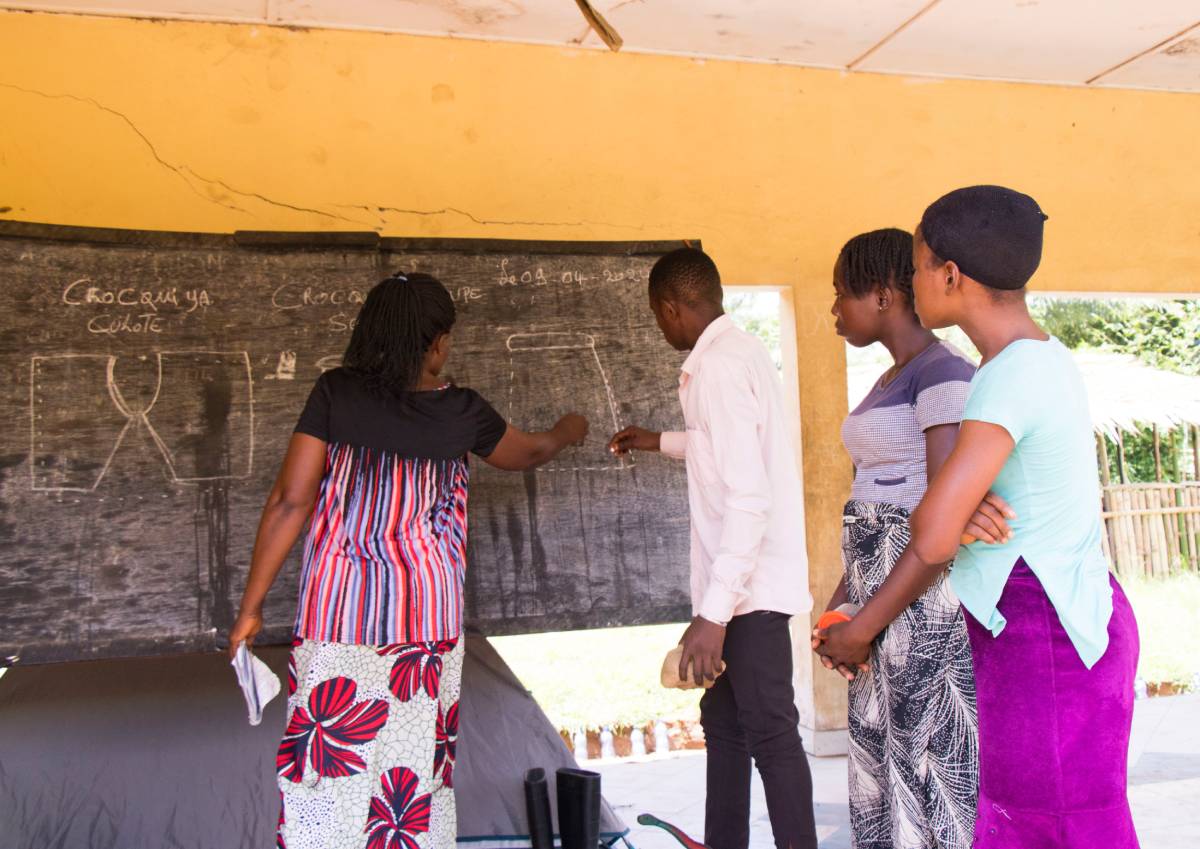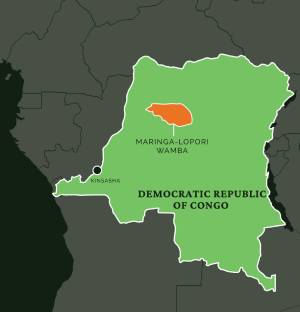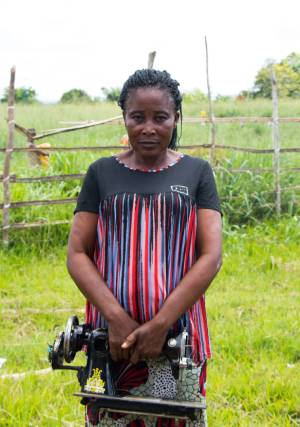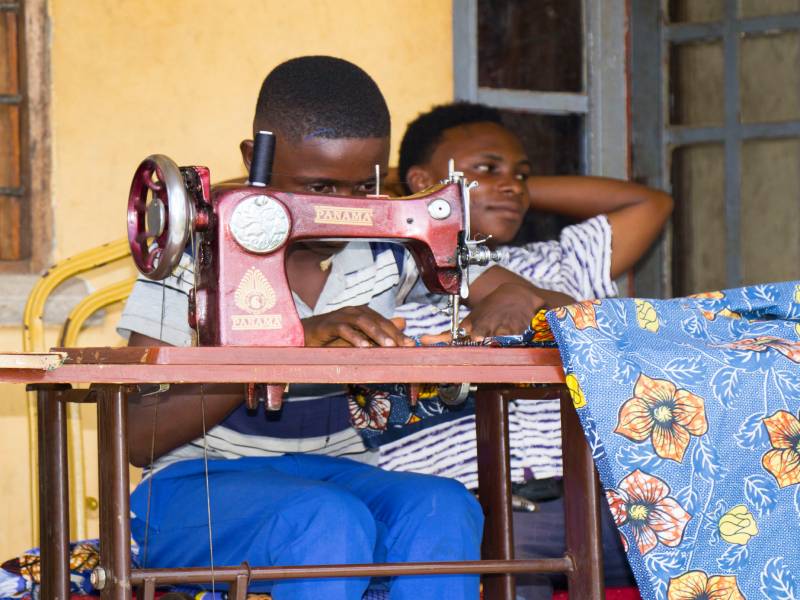Six Years On, Alternative Livelihoods Empower Women and Youth

Patience Bongole Bolumbu with her students at her workshop in Bongandanga, a town in the Maringa-Lopori-Wamba Landscape.
Patience Bongole Bolumbu, a 49-year-old mother of four, stands beside a chalkboard in her modest workshop in Bongandanga, a town within the Maringa-Lopori-Wamba Landscape north-central of the Democratic Republic of the Congo (DRC). Dressed in a vibrant blouse paired with a colorful floral loincloth, she demonstrates stitching techniques as her three students follow attentively. What began as a cutting and sewing program in this remote landscape has evolved into a transformative project six years later, offering sustainable incomes and fostering environmental stewardship.
This ecologically rich landscape located more than 1,000 kilometers from Kinshasha, the capital of the DRC, spans over 72,000 square kilometers. It is home to endangered species like bonobos, found only in the DRC. Here, many families rely on hunting for sustenance and income—a practice essential for survival but one that puts a strain on local wildlife populations.

Maringa Lopori Wamba Landscape, DRC.
From 2013 to 2018, the African Wildlife Foundation (AWF), with support from the USAID-funded Central African Forest Ecosystem Conservation (CAFEC) program, implemented a community-centered initiative to empower women by introducing alternative income-generating activities. The goal was to reduce reliance on bushmeat, support wildlife conservation, and promote sustainable economic and ecological growth.
Bolumbu was among the women who engaged in the program. After training in cutting and sewing, she quickly excelled, becoming a group leader and expanding her efforts to support others.
“Before joining the AWF training program, I sold bushmeat like many other women in my region. However, since this product is perishable, I often suffered losses due to a lack of customers,” she explained “When AWF offered sewing training, I saw it as a more reliable way to earn income, while also realizing that my previous work affected local biodiversity.”
Through her mentorship, over 100 women have gained tailoring skills, with more than 50 completing an intensive six-month program. Her workshops now attract students from neighboring towns and communities, some traveling up to 100 kilometers to learn from her, highlighting the enduring impact of AWF’s intervention.

Patience Bongole Bolumbu.
“The network keeps growing,” she notes with pride. “Many of these women have started their own workshops, providing sustainable incomes for their families.” The economic impact has been substantial—women in the program can now earn up to 200,000 Congolese francs (about US $70) during peak seasons, a significant income boost in a region where most people live on less than US $1.25 a day.
“My dream is to help women and men see that conservation is about giving back,” Bolumbu explains. As she teaches tailoring, she emphasizes the importance of conserving natural resources, helping students understand how protecting the forest supports long-term prosperity.
Although the initial focus was on empowering women, Bolumbu also saw the importance of including young men, offering them alternative livelihood options beyond hunting. One of her students, 17-year-old Parisien Elombe, appreciates the opportunity. “I never thought I would learn to sew,” he shares, “but now I have a way to make my own income instead of hunting.”
Community-Led Conservation and Sustainable Development
In partnership with the Congolese Institute for Nature Conservation (ICCN), AWF has empowered the community to become advocates for conservation around the Lomako Yokokala Wildlife Reserve. Together, they organize awareness campaigns in neighboring villages, explaining how preserving the forest opens doors to tourism, sustainable agriculture, and eco-friendly enterprises.
AWF’s integrated approach in the Maringa-Lopori-Wamba Landscape is part of a broader mission to foster community-led conservation and sustainable development. The intervention introduced new cultivation techniques, encouraging communities to give up slash-and-burn farming.
“Six years later, we are proud of the achievements and empowerment fostered by the Central African Forest Ecosystem Conservation (CAFEC) program, supported by our donor, USAID,” highlights Antoine Tabu, AWF’s Country Coordinator in DRC.
With the CAFEC program’s success, AWF has mapped over 374,100 ha of permanent forest, designated areas for sustainable agriculture, and established seven community-managed forest concessions. These efforts reinforce sustainable livelihoods and conservation for the future.
The program was also implemented in Basankusu and Djolu, and currently, there are plans to establish a new incubator center to train women in entrepreneurship, conservation, and other locally relevant skills. This center will serve as a hub for innovation, allowing women to develop businesses aligned with environmental conservation.

Parisien Elombe, 17, a student at Bolombu's Workshop.
“The women we work with aren’t just learning skills; they’re becoming leaders in their communities,” Tabu notes. “Through education and opportunity, they’re transforming the Maringa-Lopori-Wamba into a landscape where both people and wildlife can thrive.”
Through the program, AWF has enhanced the management of protected areas in the Maringa-Lopori-Wamba landscape and established clear rules and management principles for Community Forest Concessions. In addition to promoting sustainable farming practices, the program has strengthened law enforcement, supporting efforts to curb illegal wildlife trade.